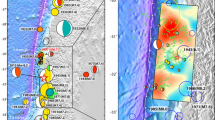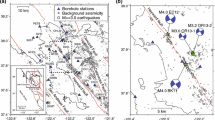Abstract
We have determined the rupture history of the March 28, 1964, Prince Williams Sound earthquake (M w=9.2) from long-period WWSSNP-wave seismograms. Source time functions determined from the long-periodP waves indicate two major pulses of moment release. The first and largest moment pulse has a duration of approximately 100 seconds with a relatively smooth onset which reaches a peak moment release rate at about 75 seconds into the rupture. The second smaller pulse of moment release starts at approximately 160 seconds after the origin time and has a duration of roughly 40 seconds. Because of the large size of this event and thus a deficiency of on-scale, digitizableP-wave seismograms, it is impossible to uniquely invert for the location of moment release. However, if we assume a rupture direction based on the aftershock distribution and the results of surface wave directivity studies we are able to locate the spatial distribution of moment along the length of the fault. The first moment pulse most likely initiated near the epicenter at the northeastern down-dip edge of the aftershock area and then spread over the fault surface in a semi-circular fashion until the full width of the fault was activated. The rupture then extended toward the southwest approximately 300 km (Ruff andKanamori, 1983). The second moment pulse was located in the vicinity of Kodiak Island, starting at ∼500 km southwest of the epicenter and extending to about 600 km. Although the aftershock area extends southwest past the second moment pulse by at least 100 km, the moment release remained low. We interpret the 1964 Prince William Sound earthquake as a multiple asperity rupture with a very large dominant asperity in the epicentral region and a second major, but smaller, asperity in the Kodiak Island region.
The zone that ruptured in the 1964 earthquake is segmented into two regions corresponding to the two regions of concentrated moment release. Historical earthquake data suggest that these segments behaved independently during previous events. The Kodiak Island region appears to rupture more frequently with previous events occurring in 1900, 1854, 1844, and 1792. In contrast, the Prince William Sound region has much longer recurrence intervals on the order of 400–1000 years.
Similar content being viewed by others
References
Astiz, L., Lay, T., andKanamori, H. (1988),Large Intermediate Depth Earthquakes and the Subduction Process, Phys. Earth Planet. Inter.53, 80–166.
Beck, S. L., andChristensen, D. H. (1991),Rupture Process of the February 4, 1965, Rat Islands Earthquake, J. Geophys. Res.96, 2205–2221.
Boyd, T. M. (1986),The Andreanof Islands Earthquake: Previous Rupture History (abstract), EOS67, 1082.
Boyd, T. M., andNabelek, J. L. (1988),Rupture Process of the Andreanof Islands Earthquake of May 7, 1986, Bull. Seismol. Soc. Am.78, 1653–1673.
Bruns, T. R. (1983),Model for the Origin of the Yakutat Block, an Accreting Terrane in the Northern Gulf of Alaska, Geology11, 718–721.
Byrne, D. E., Davis, D. M., andSykes, L. R. (1988),Loci and Maximum Size of Thrust Earthquakes and the Mechanics of the Shallow Region of Subduction Zones, Tectonics7, 833–857.
Christensen, D. H., andRuff, L. J. (1988),Seismic Coupling and Outer-rise Earthquakes, J. Geophys. Res.93, 13,421–13,444.
Cloos, M. (1992),Thrust-type Subduction-zone Earthquakes and Seamount Asperities: A Physical Model for Seismic Rupture, Geology20, 601–604.
Combellick, R. A., andReger, R. D. (1988),Evaluation of Holocene Subsidence Events of Cook Inlet Estuarine Flats near Anchorage Alaska, as a Basis for Assessing Seismic Hazards in Southcentral Alaska, U.S. Geol. Sur. Open File Rep.88–434, 463–464.
Davies, J. N., andHouse, L. (1979),Aleutian Subduction Zone Seismicity, Volcano-trench Separation, and their Relation to Great Thrust-type Earthquakes, J. Geophys. Res.84, 4583–4591.
Davies, J. N., Sykes, L., House, L., andJacob, K. (1981),Shumagin Seismic Gap, Alaskan Peninsula: History of Great Earthquakes, Tectonic Setting, and Evidence for High Seismic Potential, J. Geophys. Res.86, 3821–3855.
DeMets, C., Gordon, R. G., Argus, D. F., andStein, S. (1990),Current Plate Motions, Geophys. J. Inter.101, 425–478.
Dmowska, R., Rice, J. R., Lovison, L. C., andJosell, D. (1988),Stress Transfer and Seismic Phenomena in Coupled Subduction Zones during the Earthquake Cycle, J. Geophys. Res.93, 7869–7884.
Dmowska, R., andLovison, L. C. (1992),Influence of Asperities along Subduction Interfaces on the Stressing and Seismicity of Adjacent Areas, Tectonophysics211, 23–43.
Fuis, G. S., andAmbos, E. L.,Deep structure of the Contact Fault and Prince William Terrane: Preliminary results of the 1985 TACT seismic-refraction survey. InThe U.S. Geological Survey in Alaska—Accomplishments during 1985 (Bartsch-Winkler, S. ed.) (U.S. Geol. Surv. Circ.978, 1986) pp. 41–45.
Fuis, G. S., Ambos, E. L., Mooney, W. D., Christensen, N. I., andGeist, E. (1991),Crustal Structure of Accreted Terranes in Southern Alaska, Chugach Mountains and Copper River Basin, from Seismic Refraction Results, J. Geophys. Res.96, 4187–4227.
Fuis, G. S., andPlafker, G. (1991),Evolution of Deep Structure along the Trans-Alaska Crustal Transect, Chugach Mountains and Copper River Basin, Southern Alaska, J. Geophys. Res.96, 4229–4253.
Furumoto, A. S. (1965),Analysis of Rayleigh Wave. Part II in Source Mechanism Study of the Alaska Earthquake and Tsunami of March 27, 1964, Report HIG-65-17, Honolulu: University of Hawaii, Institute of Geophysics, December, 31–42.
Harding, S. T., andAlgermissen, S. T. (1969),Focal Mechanism of the Prince William Sound, Alaska Earthquake of March 28, 1964, Bull. Seismol. Soc. Am.59, 799–811.
Hatori, T. (1981),Tsunami Magnitude and Source Area of Aleutian-Alaska Tsunamis, Bull. Earthquake Res. Inst.56, 97–110.
Holdahl, S. R., andSauber, J. M. (1992),Coseismic Slip and Post-seismic Deformation Associated with the 1964 Prince William Sound Earthquake, Wadati Conference on Great Subduction Earthquakes, Sept. 16–19, 1992, pp. 83–89.
House, L. S., Sykes, L. R., Davies, J. N., andJacob, K. H.,Identification of a possible seismic gap near Unalaska Island, eastern Aleutians, Alaska. InEarthquake Prediction—An International Review, Maurice Ewing Ser., Vol. 4 (Simpson, D. W., and Richards, P. G., eds.) (American Geophysical Union, Washington, D.C. 1981) pp. 81–92.
Houston, H., andEngdahl, E. R. (1989),A Comparison of the Spatio-temporal Distribution of Moment Release for the 1986 Andreanof Islands Earthquake with Relocated Seismicity, Geophys. Res. Lett.16, 1421–1424.
Jacob, K. H., Nakamura, K., andDavies, J. N.,Trench-volcano gap along the Alaska-Aleutian arc: Facts, and speculations on the role of terrigenous sediments for subduction. InIsland Arcs, Deep Sea Trenches, and Back-arc Basins, Maurice Ewing Series, vol. 1 (Talwani, M., and Pitman III, W. C., eds.) (Am. Geophys. Union, Washington, D. C. 1977) pp. 243–258.
Johnson, J. M., andSatake, K. (1993),Source Parameters of the 1957 Aleutian Earthquake from Tsunami Waveforms, Geophys. Res. Lett.20, 1487–1490.
Johnson, J. M., Tanioka, Y., Ruff, L. J., Satake, K., Kanamori, H., andSykes, L. R. (1994),The 1957 Great Aleutian Earthquake, Pure and Appl. Geophys, present volume.
Kanamori, H. (1970),The Alaska Earthquake of 1964: Radiation of Long-period Surface Waves and Source Mechanism, J. Geophys. Res.75, 5029–5040.
Kanamori, H. (1977),The Energy Release in Great Earthquakes, J. Geophys. Res.82, 2981–2987.
Kienle, J., Swanson, S. E., andPulpan, H.,Magmatism and subduction in the eastern Aleutian arc. InArc Volcanism: Physics and Tectonics (Shimozuru, D., and Yokoyama, I., eds.) (Terra Scientific Publishing Company, Tokyo 1983) pp. 191–224.
Kikuchi, M., andKanamori, H. (1982),Inversion of Complex Body Waves, Bull. Seismol. Soc. Am.72, 491–506.
Kikuchi, M., andFukao, Y. (1987),Inversion of Long-period P-waves from Great Earthquakes along Subduction Zones, Tectonophysics144, 231–247.
Lahr, J. C., andPlafker, G. (1980),Holocene Pacific-North American Plate Interaction in Southern Alaska: Implications for the Yakataga Seismic Gap, Geology8, 483–486.
Lay, T., Astiz, L., Kanamori, H., andChristensen, D. H. (1989),Temporal Variation of Large Interplate Earthquakes in Coupled Subduction Zones, Phys. Earth Planet. Inter.54, 258–312.
National Academy of Sciences,The Great Alaska Earthquake of 1964, 8 Volumes (Washington, D.C. 1972).
Naugler, F. P., andWageman, J. M. (1973),Gulf of Alaska: Magnetic Anomalies, Fracture Zones, and Plate Interations, Geol. Soc. Am. Bull.84, 1575–1584.
Nishenko, S. P., andBuland, R. (1987),A Generic Recurrence Interval Distribution for Earthquake Forecasting, Bull. Seismol. Soc. Am.77, 1382–1399.
Nishenko, S. P., andJacob, K. H. (1990),Seismic Potential of the Queen Charlotte-Alaska-Aleutian Seismic Zone, J. Geophys. Res.95, 2511–2532.
Page, R. A., Stephens, C. D., andLahr, J. C. (1989),Seismicity of the Wrangell and Aleutian Wadati-Benioff Zones and the North American Plate along the Trans-Alaska Crustal Transect, Chugach Mountains and Copper River Basin, Southern Alaska, J. Geophys. Res.94, 16059–16082.
Page, R. A., Lahr, J. C., Stephens, C. D., Fogleman, K. A., Brocher, T. M., andFisher, M. A. (1992),Seismicity and Stress Orientation in the Alaska Subduction Zone after the Great 1964 Earthquake and Speculation on the Origin of a Giant Asperity, Wadati Conference on Great Subduction Earthquakes, Sept. 16–19, 1992, 31–32.
Plafker, G. (1969),Tectonics of the March 27, 1964 Alaska Earthquake, U.S. Geol. Surv. Prof. Pap.543-I, 74 pp.
Plafker, G. (1986),Geologic Studies Related to Earthquake Potential and Recurrence in the “Yakataga Seismic Gap,” U.S. Geol. Surv. Open File Rep.86–92, 135–143.
Plafker, G.,Regional geology and petroleum potential of the northern Gulf of Alaska continental margin. InGeology and Resource Potential of the Continental Margin of Western North America and Adjacent Ocean Basins, Earth Sci. Ser., vol. 6 (Scholl, D. W., Grantz, A., and Vedder, J. G., eds.) (American Association of Petroleum Geologists, Tulsa, Okla. 1987) pp. 229–268.
Ruff, L., andKanamori, H. (1983),The Rupture Process and Asperity Distribution of Great Earthquakes from Long-period Diffracted P Waves, Phys. Earth Planet. Inter.31, 202–230.
Ruff, L.,Tomographic imaging of seismic sources. InSeismic Tomography (Nolet, G., ed.) (D. Reidel Publishing Company, Dordrecht, Holland 1987) pp. 339–366.
Ruff, L. (1989),Do Trench Sediments Affect Great Earthquake Occurrence in Subduction Zones?, Pure and Appl. Geophys.129, 263–282.
Ruff, L., Kanamori, H., andSykes, L. (1985),The 1957 Great Aleutian Earthquake (abstract), EOS66, 298.
Schwab, W. C., Bruns, T. R., andvon Huene, R. (1980),Maps Showing Structural Interpretation of Magnetic Lineaments in the Northern Gulf of Alaska, Scale 1∶1,500,000, U.S. Geol. Surv. Misc. Field Stud. Map, MF-1245.
Sherburne, R. W., Algermissen, S. T., andHarding, S. T.,The hypocenter, origin time, and magnitude of the Prince William Sound earthquake of March 28, 1964. InThe Prince William Sound, Alaska, Earthquake of 1964 and Aftershocks, vol. 2 (Leipold, L. E., ed.) (U.S. Department of Commerce, Environmental Science Services Administration, Washington, D. C. 1969) pp. 49–69.
Stauder, W., andBollinger, G. A. (1966),The Focal Mechanism of the Alaska Earthquake of March 28, 1964, and of its Aftershock Sequence, J. Geophys. Res.71, 5283–5296.
Sykes, L. R. (1971),Aftershock Zones of Great Earthquakes, Seismicity Gaps, and Earthquake Prediction for Alaska and the Aleutians, J. Geophys. Res.76, 8021–8041.
Thatcher, W. (1990),Order and Diversity in the Modes of Circum-Pacific Earthquake Recurrence, J. Geophys. Res.95, 2609–2623.
Tichelaar, B. W., andRuff, L. J. (1993),Depth of Seismic Coupling along subduction Zones, J. Geophys. Res.98, 2017–2037.
von Huene, R., andScholl, D. W. (1991),Observations at Convergent Margins Concerning Sediments Subduction, Subduction Erosion, and the Growth of Continental Crust, Reviews of Geophys.29, 279–316.
Wahr, J., andWyss, M. (1980),Interpretation of Postseismic Deformation with a Viscoelastic Relaxation Model, J. Geophys. Res.85, 6471–6477.
Wyss, M., andBrune, J. N. (1967),The Alaska Earthquake of 28 March 1964: A Complex Multiple Rupture, Bull. Seismol. Soc. Am.57, 1017–1023.
Author information
Authors and Affiliations
Rights and permissions
About this article
Cite this article
Christensen, D.H., Beck, S.L. The rupture process and tectonic implications of the great 1964 Prince William Sound earthquake. PAGEOPH 142, 29–53 (1994). https://doi.org/10.1007/BF00875967
Received:
Revised:
Accepted:
Issue Date:
DOI: https://doi.org/10.1007/BF00875967




